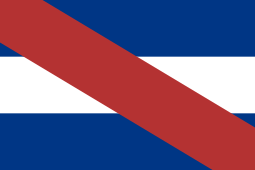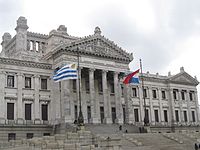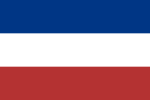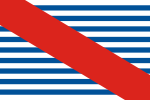Artigas flag
This article needs additional citations for verification. (September 2024) |
 | |
| Proportion | 2:3 |
|---|---|
| Adopted |
|
| Designed by | José Gervasio Artigas and José María de Roo |
 | |
| Use | Early version |
| Adopted | c. 1914 |

The Artigas flag is a flag used in the early 19th century by the South American military and political leader José Gervasio Artigas. Originally the national flag of the League of the Free Peoples between 1815 and 1820. Since 1952, it has been one of the national flags of Uruguay and since 1987, the flag of the Argentine province of Entre Ríos.[1] The flag consists of a white horizontal stripe between two blue and red bend. The blue and white stripes come from the flag created by Manuel Belgrano, while the red was added as a symbol of the fight for federalism.
History
[edit]Origin
[edit]In 1810, as a result of the May Revolution, the Viceroyalty of Rio de la Plata declared independence, becoming the United Provinces of South America, but for some time continued to use the Spanish flag. On 27 February 1812, Manuel Belgrano designed a flag for his soldiers with two blue stripes on the edges and a white stripe in the middle and proposed it as the flag of the United Provinces, however, due to the complicated situation, the Primera Junta officially fought on behalf of the Spanish King Ferdinand VII, who was in captivity to Napoleon.
In 1814 José Gervasio Artigas, the leader of the Provincia Oriental, began to organize the League of the Free Peoples. The first flag was created before the League was formed and was based on the Belgano flag. The flag consisted of horizontal blue-white-blue bands, with each blue band having a horizontal red band inside. The blue stripes were to symbolize the two banks of the Río de la Plata.
Later, Artigas changed the two red stripes to one diagonal one, to clearly distinguish his flags from similar flags of his opponents. The final design was not created directly by Artigas but by José María de Roo, a customs official from Montevideo and an expert in heraldry. De Roo likely served as a consultant to Artigas, though the exact nature of their collaboration and the extent of Artigas's influence on the design remain unclear[2][3]
Federal League
[edit]The new flag was first raised at Artigas's military camp in Arerunguá on 13 January 1815. In Montevideo it was flown for the first time on 26 March by order of the military governor of Montevideo, Colonel Fernando Otorgués, and in Entre Ríos on 13 March. Over time, the flag spread throughout the League. In 1820, after defeating the Unitarian forces, the governors of the provinces of Entre Ríos, Santa Fe, and Corrientes signed the Treaty of Pilar with Buenos Aires and reunited with the United Provinces, thus dissolving the Federal League. Faced with the Portuguese invasion and conflict with his former allies, Artigas was defeated and fled to Paraguay. Pursuing Artigas, the governor of Entre Ríos, Francisco Ramírez, captured the city of Corrientes on 19 September, declaring himself governor of the province of Corrientes and all of Mesopotamia.
After the fall of the League
[edit]Ramírez created a Republic of Entre Ríos from the territories he controlled in September 1820. Despite the title "Republic" and its practical independence, Ramírez had no intention of seceding from the United Provinces. Entre Ríos quickly came into conflict with Estanislao López, governor of Santa Fe. Since Ramírez used Artigas' old flag as his own, Santa Fe abandoned it and adopted its own design. The republic came to an end a year later when, during the campaign in Santa Fe, Ramírez was betrayed by one of his commanders, Lucio Norberto Mansilla, and then killed after being captured by López's troops.[4]
After the restoration of the province of Entre Ríos by Governor Lucio Mansilla in 1821, on 12 March 1822, the provincial congress banned the use of the federal flag and any other flags used and instead introduced new symbols. Following Mansilla's resignation in 1824, during the government of Juan León Solas, the Ramírez flag informally returned to the province along with the national flag, although it was not formalized due to factional fighting in the following years.[5][6]
Dark blue, white and red were widely used by the Federalist Party throughout its existence, but the Artigas flag itself was used less and less compared to the Rosas flag and the provincial flags.
Modern Use
[edit]
The Artigas flag remained one of the patriotic symbols in Uruguay, but it had no official status or any specific role until the 18 February 1952. On that day, a decree came into force which, among other things, recognized the Artigas flag and the flag of the Treinta y Tres as national symbols and introduced a hierarchy recognizing the Artigas flag in fourth place behind the national flag, coat of arms and anthem.
On 5 March 1987, Governor Sergio Montiel restored the Artigas flag as the flag of the Ente Rios province.
Flags of the League's provinces
[edit]The diagonal stripe pattern did not become common throughout the league right away. Especially in 1815, other arrangements of federal colors were used locally. Usually these flags took the form of simple tricolors. Apparently, the military governor of Montevideo, Fernando Otorgués, and the commander, Andrés Guacurarí, entering Misiones, used three horizontal stripes from the top of the colors red, blue and white. Otorgués flag quickly changed the order of the stripes to blue-white-red and became the Banda Oriental flag used throughout the period of the League's control over the eastern bank of the Uruguay River. The Banda Oriental flag was again used as the basis for the flag of the Treinta y Tres and as the first flag of the Republic of Uruguay in 1825.
Legacy
[edit]Argentina
[edit]Current
[edit]-
Flag of Santa Fe since 1986
-
Flag of Córdoba since 2010
-
Flag of La Rioja since 1986
-
Flag of Misiones since 1992
-
Flag of Entre Ríos Province since 1987
-
Flag of Santiago del Estero since 1985
-
Flag of city of Corrientes since 2014
Historical
[edit]-
Flag of the Argentine Confederation (1835–1850)
-
Flag of the Argentine Confederation (1850–1861)
-
Flag of Entre Ríos (1833-1853)
-
Flag of Santa Fe (De Jure 1821–1822)
-
Flag of Santa Fe (1822–1880)
-
Flag of the Republic of Tucumán (1820–1821)
Uruguay
[edit]Uruguayan Navy
[edit]From 1930s to 1990s, warships of the Uruguayan Navy flew the Artigas flag as the naval jack, until being replaced by modified pre-1930s design in recent years.[when?]
Uruguayan Air Force
[edit]-
Flag of the Uruguayan Air Force
-
Roundel of Uruguay
The aircraft of the Uruguayan Air Force display the Artigas flag on the fins, as well as a circular version of the flag (roundel) on the fuselages and wings.
Uruguayan army and general military use
[edit]-
Military Cockade of Uruguay
There is also a different version of the roundel, known as the Artigas' cockade, which is worn as a cockade on the uniforms of the military of Uruguay, and also serves as the emblem of the Uruguayan Army. It is likewise based on the Artigas flag, but with blue at the centre, surrounded by white then blue, and with the red diagonal stripe overall.
Departments
[edit]-
Flag of Canelones Department since 2010
-
Flag of Paysandú Department since 1992
-
Flag of Soriano Department since 1994
-
Coat of Arms of Artigas Department since 1964
-
Coat of arms of Rocha Department
-
Coat of arms of San José Department since 1926
Other
[edit]The symbols of the first division football Club Nacional de Football were inspired by the Artigas flag, as were those of the third division club Club Atlético Artigas and Paysandú Fútbol Club.
The political party Cabildo Abierto uses the first version of the Artigas flag in its logo, and the flag itself is also frequently used.
References
[edit]- ^ "Bandera de Artigas" (in Spanish). Embajada de Uruguay en Argentina.
- ^ Fiorotto, Daniel Tirso. "¿Quién diseñó de verdad la bandera entrerriana?". Uno Entre Rios. Retrieved 18 January 2025.
- ^ "Día de la Bandera". Educ.ar. 2003. Archived from the original on 17 July 2004.
- ^ Fiorotto, Daniel Tirso. "¿Quién diseñó de verdad la bandera entrerriana?". Uno Entre Rios. Retrieved 18 January 2025.
- ^ Chaparro, Félix A (1951). La bandera de Artigas o de la Federación y las banderas provinciales del Litoral: Corrientes, Entre Ríos, Santa Fe, Córdoba, Misiones. Librería y Editorial Castellví. p. 28.
- ^ Surt, Gustavo. "Las dos banderas que los entrerrianos debemos respetar". El Miercolesdigital. Retrieved 30 December 2024.
































